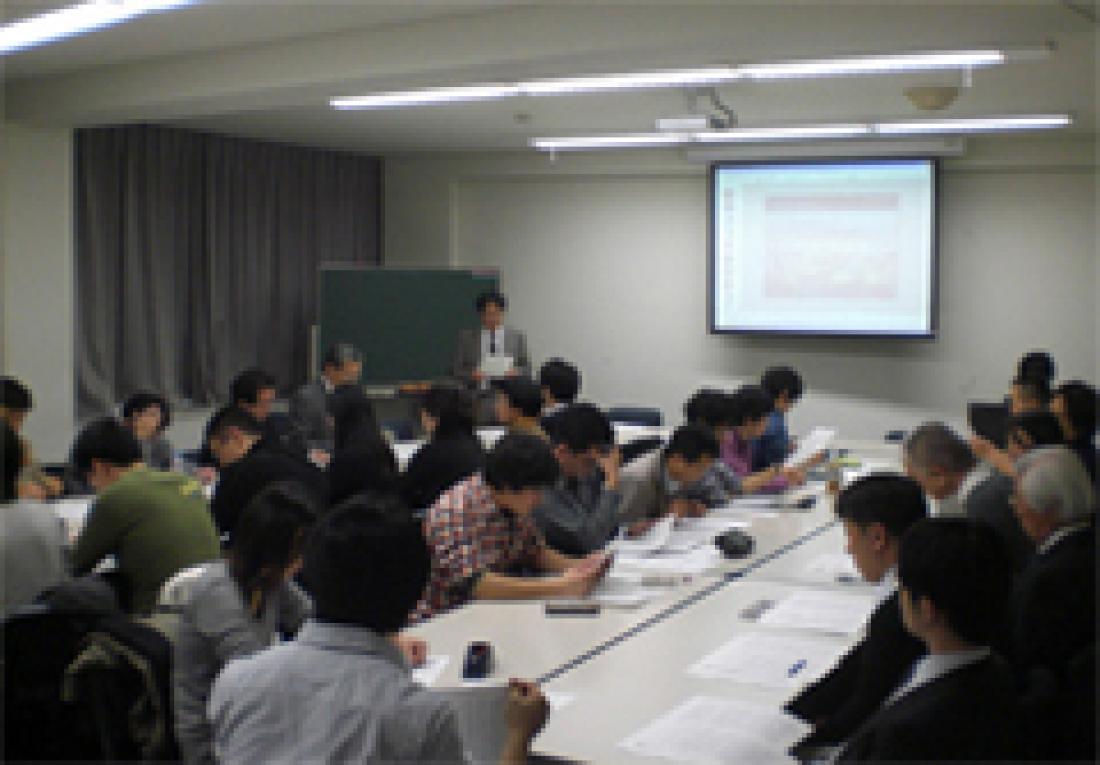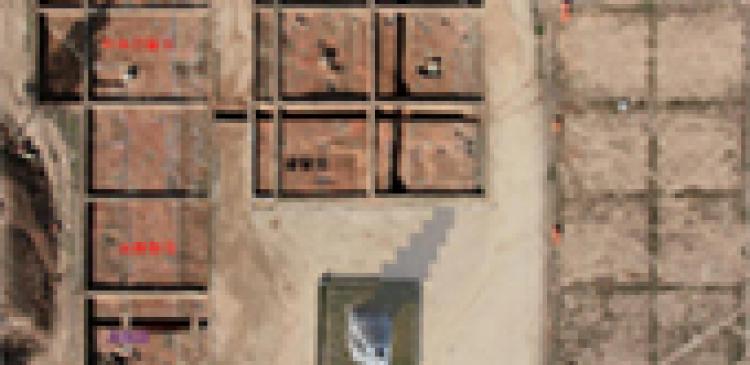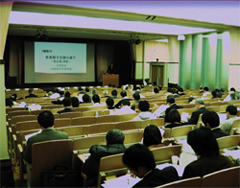Lecture meeting hosted by the public order project. “Recently Unearthed Cathedrals of Baekje” (Lecturer: Lee Byong-Ho, arts and sciences researcher at the National Museum of Korea / November 26, 2010)
When asked to mention a strong field of educational research at Waseda University, one keyword that will come up, regardless if people are from inside or outside of the university, is “Asia.” The roots of that lies in Waseda traditionally accepting many exchange students from Asia, starting with China and South Korea, and boasting many faculty members who major in Asian research. But what is surprising is that singling out Asian research related to pre-modern times for systematic promotion, has only taken place in the past 10 years.
The original motive behind that was the establishment of the "Research Center for Enhancing Local Cultures in Asia”, for five years from 2002, as a Ministry of Education, Culture, Sports, Science and Technology (MEXT)“21st Century COE Program”. Centered around faculty from the School of Letters, Arts and Sciences at the time, faculty majoring in Asian related research came together, and created a new study called Local Asian Culture, a systematic project aimed at nurturing young researchers. Based on a central theme called the Sichuan Model, an interdisciplinary project, researching the multitier relationships in pre-modern society between Chinese civilization and the cultures of neighboring regions, was promoted.
This program’s successor was “Asian Research and Local Culture” (September 2007-March 2010), which was selected as a MEXT / Japan Society for the Promotion of Science “Program for Enhancing Systematic Education in Graduate Schools” (GP). Based on the same program that provided support for involvement in methodical, systematic and quality graduate school education in order to produce high achieving personnel able to be broadly active in a wide range of fields in society, the results of the 21st Century COE Program led to the establishment of the “Asian Local Culture Course” (doctorate course) for humanities majors in the Graduate School of Letters, Arts and Sciences. In the same course, within the interdisciplinary framework called Local Asian Culture, graduate school education which has stepped away from convention has been achieved by introducing a leadership where five full-time faculty from different fields team up to instruct students undertaking diverse topics of research.
Then, in 2010, as a new start in a series of successions, the Organization for University Research Initiatives, an organized system for new strategic research at Waseda University, established the “Center for Research on “Buddhism” as a Civilization of East Asia.” We interviewed the head of the center, Faculty of Letters, Arts and Sciences Professor Katsuaki Ohashi, who has led Asian research for the 10 years since the inception of the 21st Century COE Program.
Forming a horizontal link between Asian researchers
Even at Waseda, the School of Letters, Arts and Sciences is a major base for the humane studies. In here there are highly unique fields like no others, drama research and Asian research, which consist of close to sixty percent of teachers at the Faculty of Letters, Arts and Sciences. Both these fields have been selected as research bases by the 21st Century COE Program which aids the formation of higher education research bases.
“Honestly speaking, I didn’t think we would be chosen (laughs). If you count them, there really are a lot Asian researchers, but most of them had no horizontal relationships, so at the time of application a mixture of names were put forward. Unlike the past with large rooms, each faculty member has their own laboratory and work on an individual basis. I don’t think this is limited to our university, but there were very few opportunities for professors to conduct some kind of education or research together, even if they belonged to the same department.” (Professor Ohashi)
In this environment, a few young researchers brought up the idea of applying for the 21st Century COE Program. Interested parties quickly got involved in spontaneous, cross-sectional joint research, and systemized the Asian research project institute. If selected for the 21st century COE, it would be possible to promote systematic research by employing many young researchers, inviting foreign researchers for long terms to promote joint research, and by creating official ties with international research and governmental organizations, conduct surveying and research and host symposiums. By maintaining an organized system, international research, which can not be achieved individually, becomes remarkably simple.
“We were pushed by the enthusiasm of the young ones. At the time I was Dean of the School of Letters, Arts and Sciences I and, putting aside my own future research ambitions, I thought of how I could support the young people and took on the role of flag waver for the 21st Century COE. Taking the opportunity of the good fortune of being selected, we have been able to unify the university’s Asian humanities research into a single interdisciplinary field which should be called Asian studies.” (Professor Ohashi)
As mentioned in the beginning, these ten years have panned out precisely as planned. Of the graduates from the Asian Local Culture Course doctoral course, there are already some who have become independent teachers or researchers.
From 2010, with the Center for Research on “Buddhism” as a Civilization of East Asia as a new base, we have started a five year (planned) research initiative project called “East Asian historical differences and coexistence research as seen from “Buddhism” as a migrating civilization.” We have been able to strengthen basic cooperation. The setting up of a common theme passing horizontally through differing fields of study has been devised for the next step. That theme is “the propagation of Buddhist civilization in pre-modern East Asia.”
Desire for commonality in East Asia
In 10 years, what has been brought to recognition again is the obscure concept of Asia. Regional boundaries are vague with wide areas overlapping with Middle Eastern Islamic regions. In Japan on the other hand, Asia often refers to the extremely narrow East Asian region. Things such as Asian history and Asian research clearly do not exist. In Japan, East Asian research centered on China has, up until now, occupied a central position in Asian studies under the name Oriental history. This being the case, while using existing East Asian research as a base, it is practical to devise a plan expanding East Asian research to include comparisons and relations with neighboring regions.
“After a discussion of over a year between the members, what we came up with was the commonality of the propagation of Buddhism. Buddhism began in India and was passed on to China and encompassed by the Chinese people and culture to become Chinese Buddhism. It was then in turn, starting with Japan and Korea, spread on to East Asian regions surrounding China. Researching how the propagation of Chinese Buddhism influenced each region’s society and culture is our theme this time.” (Professor Ohashi)
The project is split into three groups for research. (1) Intersections with social (common) order, (2) formations and various expressions, and (3) conjugation as a religion. (1) Intersections with social order project looks into how social (common) order was induced and wakened in East Asia by encounters with Buddhist civilization, (2) Expression project researches how forms of expression and arts and crafts developed with the migration of Buddhist civilization, and (3) conjugated religion project looks at what religions were created through encounters with Buddhist civilization (mergers with Taoism, occultism, the Way of Yin and Yang, Shintoism and popular customs and the practice of religious observances.)
“By understanding pre-modern East Asia, I think we can better see modern East Asia from a different angle. For example, in our country Buddhism and kanji were introduced together and kanji was used to write the Japanese language. There was no written language before the introduction of kanji, and for kanji to be used as the Japanese written language Manyo-gana was devised, katakana was created as an abbreviation of kanji, and hiragana made by breaking down the kanji.” (Professor Ohashi)
By following these new background interpretations, research reviewing the interpretations of existing research is also taking place. For example, at the back of the Shaka triad statue housed in the main hall of Horyuji Temple is an inscription carved in 623. It is said to have been written in the year following the death of Prince Shotoku in order to console his soul as a Buddhist saint but research is underway to reinvestigate the circumstances in what it was written and what meaning it holds.
Releasing the results of a centripetal theme
Furthermore, an even more centripetal theme embracing the whole project is set every year, with activities such as symposiums and publications taking place. Under the 2010 theme of “Relationships Between Royal Authorities and Buddhism,” in December lecturers from overseas and other universities in Japan were invited to a symposium titled “Constructing Sovereign Rule and “Buddhist” Civilizations: With Japan at the Center”. A draft is being prepared based on the contents of the presentations to be published in book form some time in 2011.
“10 years ago I would never have thought we would have progressed to a stage of such systematic cooperation. Every now and then we are also cooperating with the modern Asia research group. In East Asia, this university has a strong sense of mission, as an international educational research base, of having to lead in Asian research. This research initiative has a feeling of capping off all we have done up to now.” (Professor Ohashi)
Humanities Asian research, from a different angle seen in the dynamic modern Asian research in the fields of politics, economics and sociology, will contribute to the realization of an East Asian community.





